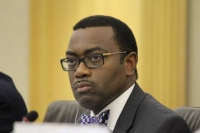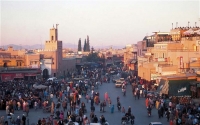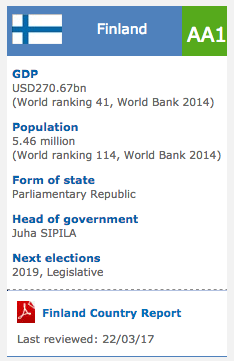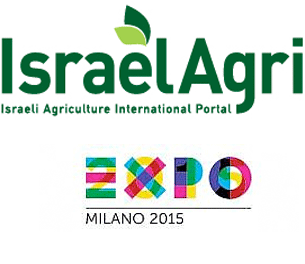Casablanca: The economic capital of Morocco
2012/11/30

The economic capital of Morocco, Casablanca is a prosperous and lively city. It represents Morocco's modernity and dynamism. Given its economic dimension, it constitutes a place for innovation, exchange and social transformation. It can by itself be considered as a metropolis that combines amount the other cities of Morocco.
Its architectural heritage "new art" represents a great tourism potential.
A series of projects are underway including the elaboration of an efficient transport system and the establishment of modern infrastructures. The city will as well benefit from projects that would reinforce its offer in terms of business tourism. Casablanca is a destination that deserve to be considered for business.
A liberal and dynamic economy
Industry is a predominant activity in Casablanca and constitutes a strong catalyst for increase and for the extension of the urban tissue. Today, this urban center boasts 55% of the country's productive units and nearly 60% of the industrial manpower. It dominates the national industrial space with a significant productive capacity, the diversity of the products and its position at the top of the hierarchy of industrial centers of the country.
This supremacy is even extra significant when we consider the activities that serve or accompany industry. In fact, Casablanca employs 39% of manpower, represents 35% of national electrical consumption and absorbs 1.231 millions of tones of cement.
The ports of Casablanca and Mohammedia ensure 55% of external exchanges. Its airport serves 51% of passengers.
A skilled and abundant manpower
An significant human potential and an efficient professional training system:
Professional training is currently at the heart of the problematic of employment promotion and integration of populations in the active life; a problematic that is set up by agreement makers as a national priority.
It as well given priority in the governmental policy aiming at developing the human resources of businesses to improve their performance et their competitiveness.
Given its double vocation, professional training is required to expect the changes in employment and to innovate in terms of approaches and training modes to be able to accompany the upgrading process of the national economy.
The sector of professional training has developed since 1987 a strong synergy with businesses and trade associations which are heavily involved in the planning and management of training.
- Related Articles

Africa's Relationship With China Is Ancient History
2017/07/02 In 2002 South Africa's Parliament unveiled a digital reproduction of a map - of China, the Middle East and Africa - that some speculated could be the initial map of the African continent. The Da Ming Hun Yi Tu - the Comprehensive Map of the Great Ming Empire - was drawn up around 1389 during the Ming Dynasty, according to historian Hyunhee Park.
Africa: Making Things Happen at the Bank - 'Not a Talk Shop' - Akin Adesina
2017/07/02 Dr. Akinwumi Adesina is focusing on five areas to achieve the African and world goals for a prosperous continent since becoming president of the African Development Bank - Africa's major public financial institution in September 2015. He was a keynote speaker at this month's Corporate Council on Africa's U.S.- Africa Business Summit in Washington D.C. and moderated a lively panel with five African government ministers. He as well received the Gene White Lifetime Succcess Award from the World Child Nutrition Foundation. This week, he was named the 2017 recipient of the World Food Prize, a prestigious honor that includes a $250,000 award. In an interview in Washington, DC, Adesina discussed the Development Bank's ambitious schedule and his vision for attracting the increase capital Africa needs. Posting questions for AllAfrica was Noluthando Crockett-Ntonga.
Climate change laws around the world
2017/05/14 There has been a 20-fold increase in the number of global climate change laws since 1997, according to the most comprehensive database of relevant policy and legislation. The database, produced by the Grantham Research Institute on Climate Change and the Environment and the Sabin Center on Climate Change Law, includes more than 1,200 relevant policies across 164 countries, which account for 95% of global greenhouse gas emissions.
Fitch described 2015 as a year marked by exceptionally strong agricultural output,
2016/01/16 A strong agriculture harvest put Morocco on course to post healthy increase in 2015, while structural reforms, together with strategic diversification plans targeting key sectors and regions, are as well beginning to yield results. Ratings agency Fitch described 2015 as a year marked by exceptionally strong agricultural output, with Morocco set to post GDP increase of 4.6%, up from 2.7% in 2014 at the same time as a poor harvest and low external request took their toll on the economy.
Morocco Outlook for 2015-17
2015/08/09 The country (Morocco) is situated in Northern Africa andbordering the North Atlantic Ocean and the Mediterranean Sea, between Algeria and Mauritania. Morocco is a country with 3 worlds; the Arab world, the Jewish world and the Berber world. The majority of the population is Muslim. Morocco has an area of 446,550 square kilometers and a coastline of 1,835 kilometers. The country has a population of slightly over 32 million people according to 2013 estimates. Morocco has a sizeable community of about 1.7 million expatriates living abroad, mainly in Spain, France, and Italy.
- Casablanca News
-
- AFGHANISTAN: UNWTO: International tourism – strongest half-year results since 2010
- BOTSWANA: Why governments need to support the financial sector to meet the unserved needs of smallholder farmers
- BOTSWANA: International Arrivals To Africa Reach More Than 18 Million In 2017
- CASABLANCA: Ibn Battuta International Festival to be held in November
- CASABLANCA: Casablanca makes spectacular comeback to international festival scene
- BOTSWANA: Africa: USA-Africa - No Policy? Bad Policy? or Both?
- Trending Articles
-
- SOUTH AFRICA: Nigeria and South Africa emerge from recession
- CHINA: Chinese-supported infrastructure projects change Zambia's landscape
- NIGERIA: The Security and Exchange Commission approves the 40th Annual General Meeting of Oando PLC
- UZBEKISTAN: Former deputy PM named Uzbekistan Airways head
- EUROPE: Ball Corporation Debuts Three New Aluminium Beverage Can Sizes
- AUSTRALIA: Western Australia joins two-thirds of country to ban fracking










